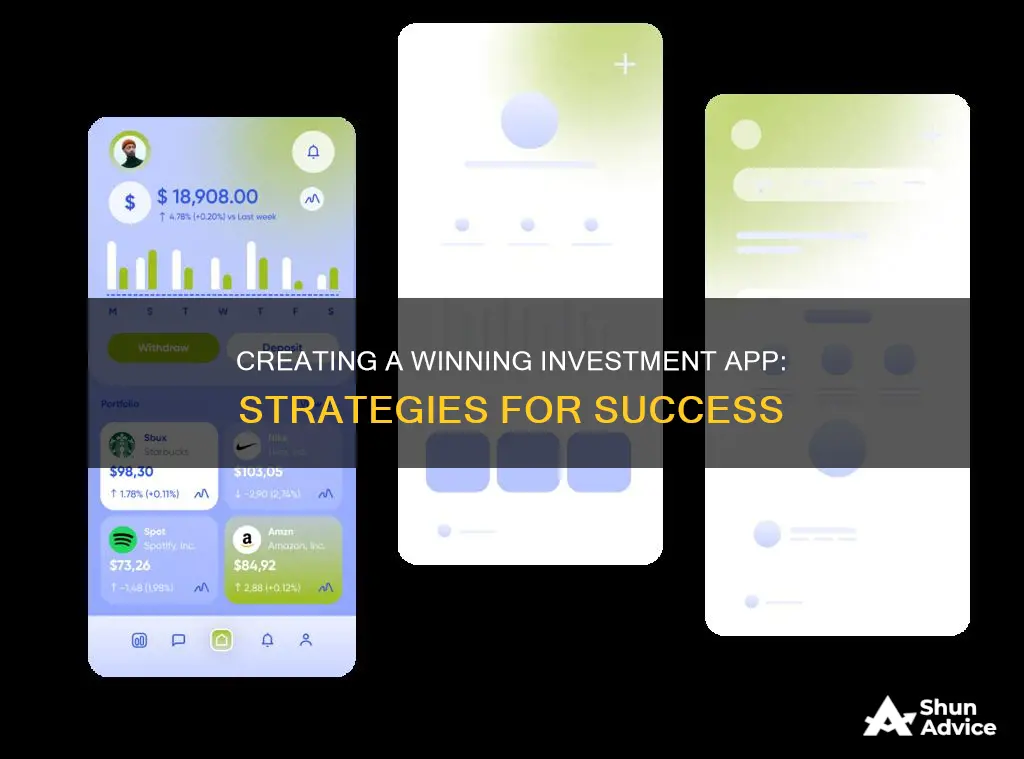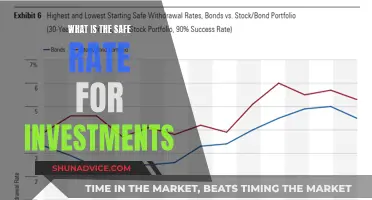
Investment apps are becoming increasingly popular, with more and more people joining these platforms to help their money grow. The market is competitive, but there is always room for new entrants, especially those with innovative ideas.
The first step in creating an investment app is setting goals. This allows you to plan the product, budget, deadline, and marketing strategy. It is also important to conduct market research to understand your target audience and competitors.
The next step is choosing a monetization strategy. There is no one-size-fits-all approach, but some common strategies include subscriptions, transaction fees, and in-app ads.
The list of features you'll integrate will depend on the type of investment app. However, all types of investment apps have some basic features in common, such as registration, login, personal profile, bank and payment systems integration, stock search and sorting, real-time analytics, and push notifications.
To create an investment app, you need a team of specialists, including a project manager, Android/iOS developers, UX/UI designers, and testers/QA engineers. You can hire freelancers, assemble an in-house team, or engage an experienced development company.
The cost of developing an investment app can range from $15,000 to $150,000 or more, depending on various factors such as the number of features, type of app, timeframes, etc.
Some essential steps to create a stand-alone investment app include conducting market research, determining your monetization strategy, complying with regulatory requirements, choosing the platform (web or mobile app), deciding on features, making a user-friendly design, developing the app using a suitable tech stack, considering data security, and launching your product.
| Characteristics | Values |
|---|---|
| Type of app | DIY, robo-advisor, hybrid, human advisor, exchange platform, cryptocurrency platform |
| Target audience | Millennials, zoomers, seasoned traders, banking employees, socially responsible civilians |
| Monetization strategy | Subscription, transaction fees, in-app advertising, partnerships, "Pay What is Fair" approach |
| Features | Registration, login, personal profile, bank and payment systems integration, stock search and sorting, real-time analytics, push notifications, virtual advisor, chatbot, news feed, profit and loss calculator, watchlist |
What You'll Learn

Define the scope of the project
The scope of the project is a crucial step in developing an investment app. Here are some key considerations to help you define the scope of your investment app:
Identify the Type of Investment App
Firstly, determine the type of investment app you want to create. There are several types of investment apps in the market, including:
- Integrated Banking and Investment Apps: These apps offer a convenient all-in-one solution by integrating both banking and investing functionalities. Examples include Revolut.
- Stand-Alone Investment Apps: These apps are solely focused on investment and can be further categorised into DIY, human advisor, robo-advisor, and hybrid advising apps. Examples include Acorns and Robinhood.
- Exchange Investment Platforms: These platforms facilitate the exchange of currencies and cryptocurrencies, as well as provide stock investment options. Examples include Binance and Coinbase.
- Cryptocurrency Platforms: These apps specialise in cryptocurrency transactions and may offer a range of digital currencies and advanced trading features.
Target Audience
Understanding your target audience is essential for tailoring your investment app to their needs and preferences. Consider factors such as age, investment experience, and financial goals when defining your target audience. For example, millennials and Gen Z may be interested in simple analytics and tips or chatbot advisors to help them take their first steps in investing.
Features and Functionality
The features and functionality you include in your investment app will depend on the type of app and your target audience. Here are some essential features to consider:
- Registration and Onboarding: Make the registration process as seamless as possible by offering multiple options, such as email, phone number, or social media sign-up. Implement biometric authentication and two-factor authentication for enhanced security.
- Personal Profile: Allow users to manage their personal data, investment portfolios, and track their profitability.
- Online Transactions: Integrate a secure payment service to enable seamless online transactions.
- Real-time Analytics and Statistics: Provide charts, graphs, and real-time data to help users make informed investment decisions.
- Push Notifications: Notify users about special offers, account activity, and market updates.
- Virtual Advisor or Chatbot: Consider incorporating AI-powered virtual advisors or chatbots to assist users with investment recommendations and risk evaluation.
- Security and Compliance: Ensure that your investment app complies with regulatory requirements, such as KYC (Know Your Customer) and AML (Anti-Money Laundering) procedures. Implement robust security measures, including encryption, two-factor authentication, and real-time fraud prevention systems.
Platform Choice
Decide whether to build a web-based investment platform or a mobile app. Consider your target audience's preferences, your budget, and the features you want to include. Web-based platforms offer more robust functionality and are often preferred by experienced investors, while mobile apps provide on-the-go access and convenience.
Development Team
Assemble a skilled development team, including project managers, Android/iOS developers, UX/UI designers, and testers/QA engineers. Consider hiring an experienced development company to benefit from their expertise and advice throughout the project.
Saving and Investing: Biblical Principles for Financial Wisdom
You may want to see also

Get your app secured
Security is one of the top concerns when it comes to trading app development. Since the development process of a stock trading app includes sensitive information, the sector is currently governed by strict regulations. To ensure your app is secure, you should:
- Use features and functionalities like bank-grade encryption, multi-factor authentication (MFA), and next-generation firewalls.
- Mitigate application security risks like XML external entities (XXE), injection, and cross-site scripting (XSS).
- Encourage your users to avoid connecting to public Wi-Fi networks when accessing investment apps to reduce the risk of unauthorized access and data interception.
- Provide a comprehensive privacy policy on how your app will collect, use, and share personal data within the app and its associated entities.
- Ask users to create strong and unique passwords to help prevent unauthorized access and enhance overall account security.
Additionally, your app should comply with financial industry regulations such as:
- Know Your Customer (KYC) and Anti-Money Laundering (AML) protocols
- General Data Protection Regulation (GDPR) in the EU
- Payment Card Industry Data Security Standard (PCI DSS)
- Security and Exchange Commission (SEC) requirements
- Financial Industry Regulatory Authority (FINRA) Rules
India Nifty 50: Tracking Index Funds for Smart Investments
You may want to see also

Design the core features
The core features of an investment app should include:
- Registration and onboarding: Allow users to register with an email address, phone number, or social media account. Implement two-factor authentication and biometric authentication for added security. Provide a comprehensive guide during onboarding to help users navigate the app effectively.
- Personal profile: Users can fill out personal details such as name, age, trading experience, and financial goals. The app can use this information to provide relevant investment options and recommendations.
- Trading management: Enable investors to buy, sell, and monitor their investments. Integrate payment services for seamless online transactions.
- Market analytics: Provide users with real-time market data, charts, performance indicators, and portfolio tracking. Offer insights on potential risks and market trends.
- Withdrawing funds: Allow users to withdraw their invested funds and provide flexibility in managing their investments.
- News and social feeds: Integrate market news and social feeds to keep users informed about financial markets and engage them in discussions with other traders.
- Customer support: Implement live chat, callback options, or direct contact with the support team to assist users with their queries or issues.
- Push notifications: Notify users about market news, emerging trends, price changes, and account updates.
Floki Inu: Guide to Investing in India
You may want to see also

Choose a monetization strategy
When it comes to choosing a monetization strategy for your investment app, there are a few options to consider. Here are some detailed suggestions to help you make an informed decision:
- In-App Advertising: This strategy involves displaying ads within your app, such as banner ads, interstitial ads, video ads, native ads, or text ads. In-app advertising is a popular choice and is projected to grow, with ad revenues expected to triple by 2025. However, it's important to strike a balance between showing relevant ads and not overwhelming users with too many advertisements.
- Freemium Model: This approach offers users a free version of your app with basic features and the option to upgrade to a premium version with additional features and benefits. For example, Spotify offers a free version with ads and a premium version without ads for a monthly subscription fee. This model allows users to try the app before committing to a purchase.
- Premium Subscriptions: This model requires users to sign up for a fixed fee immediately upon downloading the app. Premium subscriptions provide a reliable and predictable revenue stream and ensure the app remains accessible to users. However, they can be expensive for users, especially if they don't use the app frequently.
- In-App Purchases: This strategy allows users to make purchases within the app, such as buying extra lives, coins, or unlocking hidden levels in a game. In-app purchases are convenient for users and provide a flexible monetization approach for developers. They have become a major source of revenue for both gaming and non-gaming apps.
- Transaction Fees: You can charge users a fee for each transaction they make on the investment app. This could be a flat fee or a percentage of the transaction amount. This approach directly generates revenue from each user transaction.
- Hybrid Model: Combining two or more monetization strategies can be effective, such as having ads in your app and offering in-app purchases or subscriptions. This approach targets both users who are willing to pay for additional features and those who prefer to use the free version with ads.
When choosing a monetization strategy, it's important to consider your target audience, their preferences, and how they interact with your app. Additionally, you should aim to balance revenue generation with providing a positive user experience.
Strategies to Expand Your Investment Portfolio Wisely
You may want to see also

Decide on features for your app
Deciding on the features for your investment app is a crucial step in the development process. The features you choose to include will depend on the type of investment app you are creating and your target audience's specific needs. Here are some essential and optional features to consider for your investment app:
Essential Features:
- Registration and Onboarding: Offer multiple registration and login options, such as email, phone number, or social media. Ensure a smooth onboarding process by guiding users through the app's features and functionalities.
- Personal Profile: Allow users to create and manage their personal profiles, including basic information such as name, age, trading experience, and financial goals.
- Trading Management: Implement tools for buying, selling, and monitoring stocks, as well as tracking transaction history and account balances.
- Market Analytics: Provide users with real-time market data, charts, performance indicators, and portfolio recommendations based on market trends and user goals.
- Withdrawal Functionality: Enable users to withdraw their funds from the app, providing flexibility and control over their investments.
- News and Social Feeds: Integrate a news feed with market updates and a social feed for users to discuss and share insights.
- Customer Support: Offer multiple customer support options, such as live chat, callback, or direct contact with the support team to assist users with their queries and issues.
- Push Notifications: Keep users informed about market news, emerging trends, price alerts, and app updates through push notifications.
Optional Features:
- Profit and Loss Calculator: Help users calculate costs, selling prices, profit percentages, and net profits or losses.
- Watchlist: Allow users to create a watchlist to track specific stocks and their performance, helping them stay organised and make informed decisions.
- Virtual Advisor/Chatbot: Integrate a virtual advisor or chatbot feature that uses AI to evaluate risks, provide investment recommendations, and assist beginners with their investment journey.
- Multi-Currency Accounts: Consider offering multi-currency accounts for users who want to manage their global financial portfolio.
- Investment Portfolio Health Checks: Provide tools to monitor the performance of users' investment portfolios over time.
- Cryptocurrency Trading: Include cryptocurrency trading options for users interested in diversified investment opportunities.
- Investment Calculators: Offer various investment calculators to aid users in making informed decisions, such as tax calculators or compound interest calculators.
Singapore's Investment in India: Strategic Economic Alliance
You may want to see also
Frequently asked questions
There are four main types of investment apps: DIY apps, robo-advisors, hybrids, and human advisor apps. DIY apps do not provide advisory services and offer simple interfaces with basic tools for trading, creating, and managing portfolios. Robo-advisors use AI algorithms to analyse historical data, forecast market trends, and suggest the best investment options. Hybrid apps combine DIY and robo-advisor features, allowing users to either rely on technology or make their own decisions. Human advisor apps offer in-person advisory services, which can be integrated as an advanced feature.
All investment apps should include registration, login, personal profile, bank and payment systems integration, stock search and sorting, and real-time analytics and statistics. Additional features could include a profit and loss calculator, watchlists, and push notifications.
First, conduct market research to identify your target audience and their needs. Then, choose a monetization strategy, such as transaction fees, subscription models, or in-app advertising. Ensure regulatory compliance and select the platform (web or mobile app). Decide on the features, keeping in mind that the more basic ones include registration and onboarding, personal profile, online transactions, investment option ranking, news feed, virtual advisor or chatbot, and push notifications. Develop a user-friendly design and select a suitable tech stack. Prioritise data security and conduct comprehensive testing. Finally, launch your product on the relevant platforms.
The cost depends on various factors, such as the number of features, type of app, timeframes, and expertise required. The development process typically involves market research, building a minimum viable product (MVP), and adding extra features. The cost can range from $15,000 to $150,000 or more.







